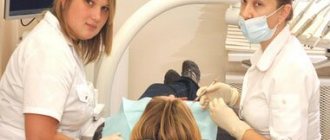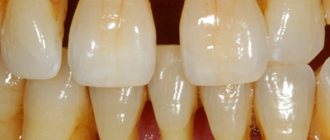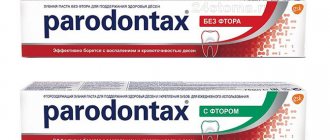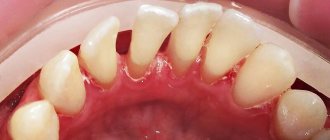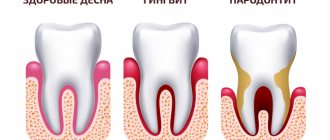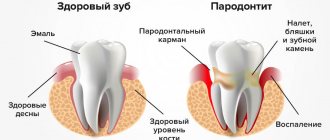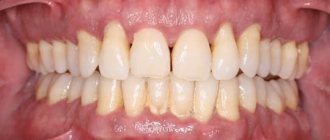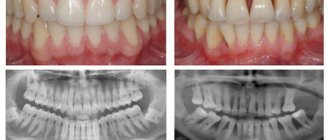Nature of the disease
Periodontitis is an acute inflammatory reaction in the gum tissue, and periodontal disease is the internal depletion and thinning of the periodontium.
Causes of diseases
Periodontitis occurs due to the penetration of pathogenic microbes into the gum tissue. This can be caused by poor oral care, non-compliance with hygiene rules, mechanical damage to the jaw, teeth and gums, or incorrectly installed dentures and implants.
The causes of periodontal disease are more difficult to establish: it may be a hereditary predisposition, the consequences of trauma to the gums and teeth, vitamin deficiency, and impaired vascular function in the tissues surrounding the teeth. Periodontal disease also develops against the background of chronic diseases of the body (for example, diabetes, diseases of the digestive system, etc.), and also often appears during pregnancy.
— What is periodontitis?
— Periodontitis is an inflammatory process of the tissues surrounding the tooth involving bone structures.
With gingivitis, which is not treated, the periodontal ligament is first affected and then, when it is lost, the pathogenic flora and plaque travel deeper along the tooth, causing loss of bone tissue and forming a “periodontal pocket.” This process can be aggressive and chronic and affects almost the entire population. In more than 90% of cases, this process develops over the years, in a sluggish form, but in the presence of some accompanying factors or decreased immunity, it can turn into an aggressive form.
(illustration from the textbook Periodontology by Wolf G.)
Stages of periodontitis from mild to severe
Severe periodontitis
The course of periodontitis and periodontal disease
Periodontitis clearly manifests itself in the first weeks and is acute: the gums bleed, hurt, and swell, so the disease is easy to recognize immediately. However, if immediate attention is not paid to treatment, the inflammation penetrates deeper, affecting the periodontal ligament - the tissue that connects the teeth. The destruction of the ligaments leads to the formation of a periodontal pocket - the detachment of the gum from the tooth, creating an environment for the formation of tartar, the accumulation of plaque on the teeth and gums, and the proliferation of bacteria. During this period of the disease, pus is often released from the gums, there is bad breath, and tooth sensitivity increases. The result of periodontitis is rotting of the gums, adjacent tissues, and exposure of the roots. The teeth become loose, the chewing function of the dentition is impaired, and a feeling of gaps appears between the teeth. The disease leads to the decomposition of the jaw bone tissue and the loss of one or more teeth.
The main difference between periodontal disease and periodontitis is that bacterial damage (periodontitis) more often affects teeth one at a time or affects several adjacent units. The disease spreads to neighboring teeth if it is not stopped in time. Periodontal disease spreads and progresses evenly throughout the entire jaw and dentition. Bone decomposition during periodontal disease does not immediately manifest itself as clear symptoms, and this is the danger of such gum disease. For a long time, tissue destruction occurs without obvious symptoms and often without pain. Visual signs of periodontal disease are tooth mobility, receding gums, exposed roots, thinning of the dentition and cracks in the enamel.
The resulting space - pockets - is attractive for the growth of bacteria, and often it is periodontal disease that becomes the cause of rapidly progressing periodontitis in several areas or in the entire oral cavity at once.
Periodontal disease itself slowly progresses and leads to the loss of the entire dentition after 10-15 years. This disease is much less common; people suffering from immunodeficiency are at risk.
Note!
Periodontitis is often called periodontal disease, without suspecting that completely different diseases are hidden behind similar names. Doctors strongly do not recommend treating periodontal disease and periodontitis at home, because only an experienced dentist can distinguish gum disease, and the methods of treating periodontal disease and periodontitis are different.
Medical treatment of gums is a long and complex process. Folk remedies for the fight against periodontal disease are ineffective, and you cannot resort to strong pharmaceutical remedies without the advice of a dentist - self-medication can aggravate the situation, ruin teeth and damage other organs.
First you need to understand what “periodontal” is and what part of the oral cavity we are talking about.
In fact, the teeth are not permanently attached to the jaw, i.e. they are attached to the bone using various soft tissues and ligaments. These include: the gums, the jaw bone itself (the bony alveolus or “socket”) and the periodontal ligament of the tooth.
If you depict it in the figure, it will look like this (in this question, the elements highlighted in red are important to us):
Now let's move on to the issue of defining periodontal disease itself.
Periodontal disease is a disease in which intensive loss of bone tissue, gums and tooth ligaments occurs.
It is very important to distinguish “Periodontal disease” from “Periodontitis”; what is the difference?
Periodontitis is an inflammatory disease of the tissues surrounding the tooth. It most often occurs as a result of poor oral hygiene. Symptoms of this disease include bleeding, swelling and pain in the gums, and tooth mobility.
Periodontal disease is a non-inflammatory disease, which means there will be no redness, bleeding or pain in the gums.
The occurrence of periodontal disease is interpreted in different ways. They are divided into systemic (i.e., arising indirectly from diseases) and local (arising due to factors acting directly on the periodontium).
The most common common causes of periodontal disease:
- Atherosclerosis (narrowing of the lumen of blood vessels due to deposition of lipid granules in the walls)
- Disruption of the endocrine glands (such as thyroid, pancreas, hypothyroidism)
- Gastrointestinal dysfunction (eg, gastritis, ulcers)
- Changes in the body's reactivity, i.e. appearance of allergies
The cause of periodontal disease and its development
Periodontal disease is a complex disease and has many causes.
The most basic reason is sclerosis (narrowing of the lumen) of blood vessels. Next, tissue trophism begins to be disrupted, i.e. there is insufficient blood supply, delivery of oxygen, nutrients and then a decrease in the number of tissues.
As a result, due to insufficient tissue nutrition, gradual resorption of bone tissue occurs, a decrease in the amount of gums, and exposure of the roots.
Factors that can lead to the development of periodontal disease include:
- Elderly age
- Cardiovascular diseases
- Diabetes
- Nervous system diseases
How to carry out early diagnosis of periodontal disease. Observation of which specialists is important for this disease. Who is at risk?
Periodontal disease is a rather difficult disease to diagnose.
But, as a rule, people experience the following symptoms:
- Reduced gums and decreased bone tissue (the most important symptom!)
- Increased sensitivity of the necks of the teeth
- No gum inflammation
- No periodontal pockets
- Stable position of the tooth in the socket, even with severe gum recession
- Diseases of various body systems that indirectly indicate periodontal disease
Observation by a dentist, i.e. preventive examination once every 6 months. Then you will be referred to a highly specialized doctor - a periodontist. Also, in a regular city clinic, observation by a regular local physician is necessary so as not to miss the onset of any systemic disease.
The main risk group for development is older people. Also people exposed to constant stress, overwork, smokers, etc.
How to identify the cause and what examination methods exist.
There are quite a lot of examination methods.
- Methods for assessing the condition of bone tissue
- The X-ray method of examining teeth with periodontal disease is the most common and simplest. This method makes it possible to assess the degree of bone tissue loss and its quantity. The most common and accessible methods are: intraoral contact radiography, orthopantomogram (OPTG). The disadvantage of this method is the limited field of study.
- An orthopantomogram (OPTG) allows you to assess the condition of the alveolar processes of both jaws in one image. The disadvantage of this method is distortion in the area of the front teeth.
- Computed tomography (CT) is the most preferred research method. Thanks to it, you can build a 3D model of the human dental system. When using CT, there is practically no distortion, unlike OPTG.
- Method for assessing tooth mobility
- Palpation (without the help of special instruments)
- Periodontogram (done using a special apparatus, and then a table is filled in where the periodontal strength of various teeth is determined)
This symptom is important in periodontal disease, but can also occur in other periodontal diseases. The essence of this method is thermal diagnostics (using hot or cold water, i.e. irrigating the tooth from a syringe or by applying a cotton ball to it).
In clinical practice, there are three degrees of hyperesthesia:
- The first is that tooth tissues react to temperature stimuli (a person feels hot or cold water, but does not experience discomfort)
- Second - a person feels pain from the irritant
- Third – pain from any irritants or even without them
Removal of supra- and subgingival dental plaque. Oral hygiene
Removing supra- and subgingival plaque is essential to maintaining both periodontal and overall oral health. This is the main goal of professional oral hygiene. Tartar does not play a significant role directly in the development of periodontal disease, but indirectly it can aggravate the situation with periodontitis (see above the differences between periodontal disease and periodontitis).
There are two ways to remove hard plaque: manual and hardware.
The manual method involves the use of various hand tools to remove tartar.
These tools are different and perform different functions, respectively: scalers, curettes, excavators, smoothers, chisels, rasps.
The hardware method is more common and involves the use of a special device. These piezoelectric devices have a frequency from 25 to 45 kHz. Using these frequencies, the tip attachment breaks the contacts between the molecules of the tartar and allows you to simply wash it off with water or clean it with a special brush and paste.
Main representatives: scalers from EMS (Switzerland), Amdent Boitrol (Sweden), Satelec (France), Siroson L (SIRONA).
After treating the teeth with an ultrasonic scaler, sandblasting is carried out (if there is dark plaque) if necessary, and mechanical cleaning of the teeth with a brush and paste to remove remaining dental deposits, for example, Detartrine. Further, after such an aggressive effect on its structure, it is necessary to restore the mineral composition. To achieve this, fluoridation is carried out in various ways: varnishes, gels, etc.
After professional oral hygiene, it is necessary to replace the old toothbrush with a new one. This is necessary because an old toothbrush contains many microorganisms that can lead to an exacerbation of the same diseases that existed.
During and after treatment, oral hygiene is required 2 times a day and replacing the toothbrush once every two months.
The optimal set of dental products for periodontal disease:
- EZSH (electric prophylactic toothbrush) – if a person has the opportunity to use an EZShch, then this is better than having a manual one. An electric toothbrush should be characterized by: a round head, two-level bristles, indicating bristles (degree of wear), a timer.
- Manual protective shield (if it is impossible to purchase an electrical protection shield) – medium degree of hardness, multi-level bristles, rounded bristle tips, microtextured polymer coating, indication of the degree of wear of the bristles, rubber-plastic in the handle, comfortable grip, non-traumatic. If hyperesthesia occurs, it is possible to replace the brush from medium-hard bristles to soft ones.
- Therapeutic and prophylactic toothpaste - should contain anti-inflammatory oils and plant herbs, it is possible to introduce fluoride compounds to prevent carious lesions, should not contain strong antiseptics, and should contain a moderate abrasive. Also, if hyperesthesia occurs, it is recommended to switch to a “Sensitive” type paste.
- Therapeutic and prophylactic mouth rinses - an anti-inflammatory component in the form of extracts of herbs and plants, without strong antiseptics, with sweeteners is also possible. Regular use is required.
- Flosses (dental floss) are two-component, regular use after each meal is mandatory.
- Irrigator – if you have the opportunity to use an irrigator, then this is very good. There are 2 modes: shower and jet.
Irrigator
Treatment algorithm for periodontal disease
First, it’s worth making a reservation: is it possible to cure periodontal disease? In the early stages of the process - yes, later we are talking about stabilizing the process and stopping further bone resorption. This is done to preserve the teeth for as long as possible.
Treatment for periodontal disease includes several stages:
- Consultation with a periodontist - this doctor specializes in such problems, so he will review images and other research methods and then come up with a plan for further treatment.
- Professional oral hygiene with removal of supra- and subgingival dental plaque. I wrote above about the need for this procedure.
- Anti-inflammatory therapy - includes local and general.
- With local anti-inflammatory therapy, drugs are applied directly to the gum and have a local effect through the capillaries of the gum. Typically this treatment includes the following drugs:
- Rinse with Chlorhexidine 0.05% immediately after brushing your teeth (in the first minute)
- Applications with “Cholisal” or “Solcoseryl” gels. It is carried out after applying chlorhexidine and drying the gums.
- Closed curettage: the purpose of this method is to completely clean out periodontal pockets of possible microorganisms that cause infection. This method is used for mild periodontal disease. It is carried out using special curettes, which, under infiltration anesthesia, are introduced into the periodontal pocket and all dental plaque is removed there manually. The regime after surgery is important: do not eat for the first 2 hours after surgery, then for several days use only crushed, non-hot food and perform hygiene only with liquid products. It is better not to use a toothbrush for the first 2–3 days.
- Open curettage: performed for moderate to severe periodontal disease (depth of periodontal pockets more than 5 mm). Methodology: under infiltration anesthesia, the gum is dissected and detached. This access allows you to completely open the periodontal pocket and clean the tooth root from dental deposits. Then treatment with antiseptic drugs and application of drugs that stimulate osteogenesis (bone growth) are carried out.
- Transplantation of the soft tissue component. This operation is used when the tooth root is exposed. A patch taken from the palate is sutured onto the affected area.
- Gingivectomy is the removal of affected, inflamed, hardened gums by excision.
- Tooth extraction is a radical method, but it is necessary in cases of severe mobility, bleeding and the impossibility of restoring tooth function.
Non-traditional methods of treating periodontal disease
As an independent treatment, this type of treatment will be ineffective, because... Doctors' intervention is necessary to adequately assess the condition of the oral cavity.
And only with the permission of a doctor can unconventional methods be approved.
For example, herbal poisons that have a local anti-inflammatory effect.
Is implantation possible for periodontal disease?
Yes, this method of treatment is possible, but do not forget that no one will give you implants right away.
First, you need to undergo long-term treatment with bone restoration and only then should you talk about implantation.
{jlcommentspro}
Treatment of periodontal disease
It is rarely possible to cure periodontal disease completely: the cause of the disease lies in the weakened state of the body and the improper functioning of organs. This is why older patients most often suffer from gum disease.
However, proper treatment stops the development of the disease, prevents it from progressing, and damaged teeth and tissues can be restored.
The first stage of periodontal disease treatment is examination.
Without high-quality diagnostics and analysis of gums and teeth, it is impossible to cure periodontitis. To establish the causes of the disease, it may be necessary to examine not only the mouth, but the entire body.
At the LeaderStom clinic, examinations are carried out using modern equipment, which accurately determines the cause and extent of the lesion:
- An orthopantogram and an x-ray of the oral cavity will show how deeply the disease has penetrated and what tissues it has affected;
- Analysis of periodontal tissue (gum tissue) will reveal the presence of pathogenic bacteria and the concentration of microorganisms in the mouth.
The result of an in-depth examination of the oral cavity is a comprehensive gum treatment plan.
Diagnosis and treatment
Diagnosing periodontal disease at the initial stage is difficult, since it does not have pronounced symptoms. At this stage, the doctor conducts a visual examination and asks about the presence of risk factors. Upon examination, the general condition of the oral cavity, dental plaque, discoloration of periodontal and teeth, and bite defects are revealed. In addition, he conducts a number of specific tests to determine the condition of the periodontium. After this, the patient must undergo an X-ray or CT scan in order to assess the degree of destruction of the bone tissue of the jaws.
Treatment is prescribed based on the conditions of a specific clinical case. The following methods can be applied:
- drug therapy;
- course intake of vitamins to normalize trophism;
- physiotherapy;
- gum massage;
- professional cleaning (removal of soft and hard deposits);
- elimination of dental diseases;
- correction of occlusion (bite);
- dental prosthetics;
- course procedures using a specialized Vector periodontal device;
- surgical therapy - flap operations, for example, recession plastic;
- splinting (application of a splint to the moving elements of the dentition).
Periodontist's note: the earlier treatment is started, the higher its effectiveness. Don't delay visiting the dentist!
Treatment of periodontal disease in the early stages
When periodontal disease has not yet destroyed bone tissue, it is easier to cure teeth and gums. To begin with, ultrasonic cleaning of the oral cavity is carried out, which removes plaque, tartar and deposits.
Afterwards, drug treatment of periodontal disease is prescribed:
- General therapy includes taking hormonal and immunomodulating drugs and antibiotics. The exact selection of medications for periodontal disease is made by a dentist; the treatment method depends on the cause of the disease. This is why doctors do not recommend self-medicating without consultation and resorting to traditional medicine - these ineffective remedies create the illusion of treating teeth and gums while the disease progresses.
- Strengthening the immune system. Drugs that boost immunity actually help the body cope with the destruction of gums, tooth roots and bone tissue faster, but only a doctor can prescribe them, and only after conducting a series of tests that will show what substances the body lacks. Contrary to popular belief, special diets do not help get rid of periodontal disease, but dentists recommend excluding spicy, fatty and fried foods - such foods irritate damaged gum tissue and negatively affect the microflora of the oral cavity. It is recommended to eat more fruits and vegetables, because they strengthen the immune system.
- Local therapy. Injections into the gums for periodontitis, gels, painkillers and disinfectants. The main goal of such treatment is to prevent the return of plaque or inflammation.
Types of periodontal disease and stages of its development
A characteristic feature of this pathology is its generalization, i.e., its spread to all periodontal tissues, and not just to a separate area.
According to other parameters, periodontal disease is classified as chronic and in remission (the disease has not disappeared, but the progression of the pathology has stopped). Experts differentiate the pathological process into several stages:
- mild – there are practically no symptoms, the gums are pale, bone defects are visible only during hardware examination (x-ray or computed tomography);
- middle - characterized by a decrease in the subgingival partitions between the dental elements and exposure of their necks and even roots. At this stage, their position also changes (tilt, rotate);
- severe – increased symptoms of the middle stage plus the appearance of mobility of dental units and severe pain when chewing.
How to treat periodontitis with complications
If gum disease was not noticed immediately and has already manifested itself through external destruction - receding gum tissue, wedge-shaped changes or tooth mobility, treatment of periodontal disease will be much more difficult:
- After the examination, the dentist will indicate which teeth cannot be restored and must be removed, and will also clean the oral cavity from plaque, tartar and microbes.
- The next step in the treatment of periodontitis is splinting. The purpose of the procedure is to bind the remaining teeth and prevent further loosening and loss. A horizontal groove 1-1.5 mm deep is drilled into each tooth, into which a fiberglass construction tape is poured. A light composite is applied on top, which returns the teeth to their natural aesthetics.
- If periodontal disease has been advanced, teeth can only be restored with the help of prosthetics - making a bridge. The prosthesis not only creates an aesthetic effect, restoring the beauty of the smile, but also replaces the chewing function of lost teeth, and also strengthens and does not allow the remaining teeth to decay.
Treatment of periodontal disease is accompanied by strengthening the immune system and drug therapy. Dentists at the LeaderStom clinic will definitely tell you about caring for your teeth during and after periodontal disease treatment.
Symptoms of periodontal disease depend on the stage and characteristics of the disease.
The first stage is characterized by a complete absence of complaints and symptoms, despite the fact that pathological changes are already slowly beginning to occur in the periodontal structure. The second stage is manifested by a decrease in the interdental septa. The patient complains of blood, itching and unpleasant pain, and possible food debris getting stuck between the teeth. The third stage is the complete and irreversible destruction of the periodontal space. The main complaints are severe bleeding even with minor mechanical impact, pain, the appearance of ulcers and erosions, pathological mobility of teeth progresses, and possible tooth loss.
Treatment of periodontitis: the new Vector procedure will strengthen the gums and eliminate bleeding
Seeing blood on your toothbrush and in the sink while brushing your teeth every day is not pleasant. You can solve the problem of bleeding gums in just one visit with the help of deep mouth cleaning using the Vector device.
This procedure does not provide visible aesthetic results: the teeth do not become noticeably whiter or straighter, so patients tend to classify it as a minor procedure. This is a fatal mistake, because it is with tartar, bleeding and periodontitis that serious problems with teeth begin: loosening, exposure of roots and loss of dentition units.
The Vector device fights gum problems, strengthens tissue, cleans out inflamed pockets, destroys germs, saving gums from infection. The complex effect of Vector restores the adherence of the gums to the teeth, closing periodontal pockets that are attractive to infections.
The revolutionary principle of longitudinal movement of the Vector Paro Pro!
- Non-traumatic
- Antibacterial
- Strengthening method
It is the tartar deposited in the pockets that is the main cause of bleeding gums, since when you press on this place with a toothbrush or while eating, the gums are injured, wounds appear, into which pathogenic bacteria enter - the cause of inflammation of the oral cavity.
Complications of periodontal disease
If you do not stop the progression of the disease by starting treatment, the consequences can be depressing. Gradually, the patient will lose all his teeth, the atrophy of the jaw bones will increase, the shape of the face will change (its lower half will seem to “fall in” inward) and diction will change for the worse. Losing teeth will lead to poor digestion and, as a result, to gastroenterological and intestinal diseases. Infection from inflamed periodontal disease will spread through the blood and lymphatic vessels throughout the body. And this will lead to problems in the cardiovascular system, kidney failure, and rheumatism of the joints. In addition, purulent inflammation of the periodontium can cause periostitis (inflammation of the periosteum), abscess and phlegmon, lymphadenitis, and osteomyelitis.
For your information: periodontists of the “Smile” clinic network have extensive practical experience in the treatment of periodontal disease. The use of modern treatment methods and the use of innovative equipment make it possible to solve a patient’s problem of any severity.
The dental network offers diagnostic services and effective treatment of periodontal disease, regardless of its causes and symptoms. Contacting our branches has significant advantages. We guarantee:
- treatment by highly qualified doctors;
- adherence to a treatment protocol that meets international standards;
- family and savings discounts;
- stable cost of services;
- A work schedule convenient for patients, without days off or breaks.
You can contact any of the branches of our clinic in Moscow, located within walking distance from metro stations:
- Art. Alekseevskaya (VDNKh district, etc. Mira), address: st. 3rd Mytishchiskaya house 3, building 2;
- Art. Shelepikha, address: Shelepikhinskaya embankment, address: building 34, building 1.
Periodontal disease is a terrible disease, and therefore does not tolerate self-medication. Come to our clinic, experienced specialists will be able to help you at any stage of the disease. We can take care of your health!
Why is it important to choose Leaderstom for the treatment of periodontitis and periodontal disease?
LeaderStom is the ideal price-quality ratio for dental services: treatment of diseases of the teeth and gums is performed by highly qualified periodontists. Dentistry is developing every day, which is why our doctors undergo advanced training courses, get acquainted with new methods and devices that restore health to teeth and gums. The use of innovations, rich experience and modern methods of therapy and prevention together give a 100% result - to get rid of periodontitis in one visit to the dentist.
The doctor begins therapy only after a complete examination of the oral cavity, since some gum diseases can be the cause of other serious disorders in the body: hypovitaminosis, malfunction of organs or infectious diseases. If there are no other diseases, the periodontist performs probing (penetrating examination of the gums and teeth), based on the data of which the treatment tactics are determined.
Our main principle in treatment is adherence to high quality standards at all stages of treatment: from examination to recommendations for rehabilitation and dental care, the doctor takes care of the patient. We understand that neglect of any stage of treatment leads to relapse of the disease, which means that money for the treatment of teeth and gums was wasted. Even with the most conservative estimates, the cost of a periodontist’s work is high: from 4,000 thousand rubles. However, you cannot delay treatment - the later you start treating your gums, the higher the price for periodontitis treatment will be, and the more often you will have to visit a periodontist.
Periodontal diseases. What gum diseases are there?
Notice
: Undefined variable: post_id in
/home/c/ch75405/public_html/wp-content/themes/UltraSmile/single-item.php
on line
45 Notice
: Undefined variable: full in
/home/c/ch75405/public_html/wp-content /themes/UltraSmile/single-item.php
on line
46
Rate this article:
( 2 ratings, average: 3.00 out of 5)
gum disease
1 Beloklitskaya G.F. Clinical forms of generalized periodontitis and their significance for its differentiated therapy.
Rehabilitation after treatment of periodontal diseases.
The importance of a doctor’s recommendations cannot be underestimated, because the effectiveness of even the most modern treatment of periodontal disease and periodontitis largely depends on proper oral hygiene. Only daily brushing of teeth and caring for gums will help get rid of plaque and avoid the appearance of tartar. Massaging with the right toothbrush will have a beneficial effect on your gums, and using medicated toothpastes recommended by your doctor will protect against irritation. The periodontist at the LeaderStom clinic will tell you in detail about toothbrushes, how to choose the right toothpaste and what products to use to reliably protect the gum tissue.
If dental health is important to you and you dream of a snow-white, dazzling smile, feel free to contact Leaderstom: prices for treatment of gums, teeth, periodontitis and periodontal disease will invariably please you, and doctors will make the treatment procedure comfortable and painless. We will conduct a preventive examination, advise and help you choose oral care products, perform professional teeth cleaning and cure gum disease. New products in the field of dental equipment and doctors who have many years of experience, advanced training courses and thousands of treated teeth and gums will help with this.
Factors provoking the development of the disease
- Poor oral hygiene
- Presence of dental plaque (regardless of the reason for its formation)
- Lack of vitamins and minerals in the body
- Progressive dental diseases
- Bite defects
- Hereditary factor
- Metabolic disease
- Sharp changes in hormonal levels (pregnancy, menopause)
- Decreased bone strength
- Diabetes mellitus and other pathologies of the endocrine system
- Oncology
- Severe liver or kidney damage
- Atherosclerosis
- Nervous system diseases
- Excessive smoking
- Unbalanced diet
Important: periodontists recommend that patients with a history of even one of the listed factors regularly (at least twice a year) come to the dental clinic for a preventive examination. Early detection of the disease will reduce treatment time and save costs.
Where to treat gum diseases in Moscow?
Many patients who suffer from periodontal disease often ask the same question: how to treat periodontal disease? When you start talking to them and hear this question, you ask, why don’t you ask how to treat periodontitis?
Unfortunately, not all people know what periodontitis is, they do not understand what causes periodontal disease, they have no idea what symptoms accompany these two diseases, how to prevent the risk of their occurrence and how modern treatment of dental gums is carried out. Therefore, before looking for an answer to the question of how to treat periodontal disease, it is advisable to find out what specific periodontal tissue disease you have.
If you want to understand in detail the theoretical aspects of your gum disease, then you can, first, place a query in an Internet search engine: periodontitis symptoms and treatment. Then you can compare the symptoms that you have and the symptoms of periodontitis. It will be possible to roughly understand what kind of gum disease we are talking about in your particular case. Also, since the request “periodontitis symptoms and treatment” includes a request for treatment of gums, you will be provided with a significant list of clinics whose specialists provide treatment for periodontitis.
In this article we will tell you in detail about what periodontal disease and periodontitis are, how these diseases differ from each other, as well as the main diagnostic methods and technologies that allow for optimal treatment of gums (periodontitis).
[]
The doctors of our clinic are dental therapists:
Inessa Khautievna Fitsezh
Dentist-therapist, orthopedist
Clinical experience over 15 years
Kawas Naji
Orthopedic dentist, therapist
Clinical experience over 29 years
All doctors of our clinics »
Treatment of periodontitis at the DentaLand clinic
In our dental clinic, treatment of periodontitis, i.e. Treatment of gum diseases is carried out by dentists who treat gums using modern equipment and the latest technologies. Patients who initially come to us often find us by searching on the Internet with the request: laser gum treatment. The question arises, why this request?
Everything is quite simple. If you think about how to treat periodontal disease effectively, you will probably almost immediately understand that this requires modern treatment technologies. As a result of numerous scientific and practical studies, it has been repeatedly proven that effective treatment of periodontal disease is laser treatment of periodontal disease. It is clear that laser treatment of periodontitis is also a very broad concept. Our specialists base their work on the principles that allow effective treatment of periodontitis by treating periodontitis with a device emitting lasers of various wavelengths.
We take an individual approach to each patient when we treat gums, focusing on accurate diagnosis, affordable prices and achieving maximum results. Effective treatment of periodontitis cannot be achieved using only one type of treatment. It is inappropriate to treat periodontitis with a laser and not to use the principles of complex treatment of this disease.
Effective treatment of periodontal disease can only be comprehensive. Treatment of periodontal disease with a laser should include not only the laser radiation itself, but also the possibility of introducing medications into the gum tissue, based on the specifics of the inflammatory or degenerative process in periodontal tissues. The concept of gum periodontitis is a complex and broad reflection of a disease that is localized not only in a specific area of the gum, but is associated with the functional state of the entire organism.
Therefore, there can be only one answer to the question of how to treat periodontitis - this is not the treatment of the disease, but of all the dysfunctions of the body with the removal of the main cause of this disease. I would like to draw your attention to the fact that the term “gingival periodontitis”, generally accepted among many patients, only indicates that there is some dysfunction in the gum tissue, but does not reflect the essence of the problem, which is related to functional changes in various body systems.
With us you can get the most effective treatment for periodontitis and periodontal disease in Moscow.
[]
— What causes periodontitis?
— Improper brushing of teeth, presence of plaque on the teeth, smoking, malocclusion (crowding of teeth), imbalance in the composition of saliva, changes in hormonal status, diabetes.
Treatment of periodontitis is complex and, in most cases, successful. A guarantee of a positive result is the full interaction of the patient, therapist, orthopedist and surgeon.
Due to the presence of periodontal pockets, standard professional hygiene will be less effective, so more invasive procedures are performed to remove all plaque. After eliminating the inflammation, specialists work to stabilize the result and eliminate the causes that caused the damage.
Periodontal disease: when your gums hurt
Periodontal disease is a systemic lesion of periodontal tissue. This is a fairly rare disease that occurs in approximately 2% of the population. Unlike periodontitis, this pathology is not accompanied by inflammation of the gums and does not lead to exposure of the neck of the tooth.
This is, in fact, a progressive atrophy of the dental cells, which causes a decrease in the height of the interdental septa. The disease is also accompanied by pain under mechanical influence, for example, during eating.
What triggers the development of periodontal disease? The exact reasons have not yet been established. It is believed that hereditary predisposition plays a major role. Also, the development of periodontal disease can be influenced by the presence of systemic diseases in the body: diabetes mellitus, disruption of the endocrine system, hypertension or atherosclerosis.
Any factors that impair the blood supply to the gums can also contribute to soft tissue atrophy.
— What is periodontal disease?
— As was written above, there are practically no differences between periodontitis and periodontal disease, and due to the fact that the distinctions between diseases are quite blurred, the term periodontal disease was removed from clinical classifications.
But still, some specialists still use it, so let's look at the minor differences between these diseases.
Periodontal disease can develop asymptomatically for decades and is most often diagnosed in older people. The patient does not notice its manifestations until they become obvious, for example, pronounced tooth mobility appears. This process is rare, no more than 3% of cases.
